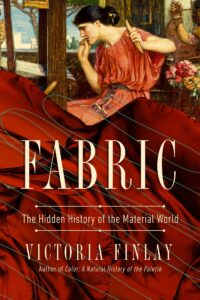SDA Book Club: “Fabric: The Hidden History of the Material World” reviewed by Vivien Zepf
November 4, 2022
Fabric: The Hidden History of the Material World by Victoria Finlay

I’m so engrossed in Victoria Finlay’s new book, Fabric: The Hidden History of the Material World, that I’m wondering, will she get firsthand knowledge about barkcloth without the benefit of fifteen bodyguards and a helicopter? I don’t notice my bumpy flight until water slops from my cup and onto my open book. Spoiler alert: Yes, Finlay spends time (without bodyguards) in a welcoming Papua New Guinea village and discovers some of the magic of barkcloth, also commonly known as tapa. As promised to the elders, she writes about the people, the importance of tapa to the community and how it “is like the heart of the Maisin… It pulls everything together, and everything leads back to it.”
In Fabric, Finlay shares her thoughts, questions, missteps (such as forgetting to check a museum exhibition schedule in advance), and “aha” moments in the retelling of her expansive research into fabric. With chapters organized by fabric type and entertaining section subtitles like “It’s almost always from Australia…,” Finlay lightly moves from topic to topic. Because Finlay travels extensively for her deep dives into tapa, cotton, wool, tweed, pashmina, sackcloth, linen, silk and imagined fabric, the facts are intertwined with a travelogue and memoir.
This entertaining mash-up really works. It also provides Finlay the opportunity to weave together robust histories that include tangential information such as regional folklore and the wisdom gathered from local experts and guides. I learned a great deal, even in subjects I felt I was already well versed in. I certainly didn’t realize there was so much to know about tweed. Another pleasure of the book lies in Finlay’s lovely writing. For instance, while observing silk moth caterpillars eat, she describes “…a gentle husky crack – like a Tic Tac box being opened surreptitiously in a cinema – when a worm finds a new piece of leaf.”
Finlay had entertained the idea of writing a book about fabric for years, but hesitated due to her father’s failing health. She didn’t want to leave her mother alone to provide for his care while she journeyed the world in search of fabric clues. Finlay’s mother encouraged her to go, saying that at some point they would share in the bond of creating a burial patchwork quilt to celebrate her father’s life. Finlay was devastated when her mother passed away unexpectedly, predeceasing her husband. It was a later exhibition about barkcloth that comforted Finlay and compelled her to pursue the project after her father’s death. In turn, Finlay’s book is also a loving tribute to her parents. Her recollections of them, as she navigates her grief, are part of this book—we browse with Finlay as she sorts through her late mother’s linen collection. And, because Finlay had hoped to find solace in a patchwork quilt, the penultimate chapter is about patchwork. It’s not a cloth, per se, but patchwork quilts are of cloth, and the chapter is a fitting epigraph.
Fabric: the Hidden History of the Material World presents readers with an in-depth course on some of the cloth that are integral to our shared experience. It’s also about grief, traditions, folklore and people. I highly recommend this book to all who’d like to curl up and get lost in the histories and stories.
- Publisher: Pegasus Books (buy it here)
- Date: November 2022
- ISBN: 9781639363902
If you’ve read this book, leave a comment and let us know what you think!
Do you have a recommendation for a recent fiber-related book you think should be included in SDA’s Book Club? Email SDA’s Managing Editor, Lauren Sinner, to let her know!

2 Comments
Louise K says
November 4, 2022 at 12:00 pm
I am looking forward to reading this book and appreciate your review. But (as an anthropologist) I was a bit put off by your opening sentences where you seem to suggest that going into a non-Western places is inherently dangerous. It is not.
Rosemary Reudelhuber says
November 5, 2022 at 5:24 am
I just finished this book and I am happy to see your post about it. She made it a thoroughly engrossing read and wove it together with the story of her mother's death. A lovely read for textile people.